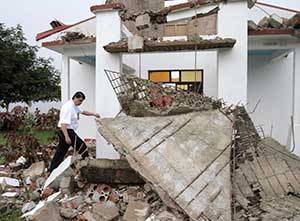SANTO DOMINGO, Dominican Republic — A strong earthquake struck northwest Costa Rica Sept. 5, killing at least two people, damaging homes and some Catholic churches, setting off a tsunami warning and rattling nerves. Costa Rica’s Minister of Public Safety Mario Zamora walks through the rubble of the damaged Bellavista Catholic Church in Bellavista after a Sept. 5 earthquake. The magnitude-7.6 quake struck northwest Costa Rica that day, killing at least two people, damaging homes and some Catholic churches. (CNS photo/Zoraida Diaz, Reuters)
Costa Rica’s Minister of Public Safety Mario Zamora walks through the rubble of the damaged Bellavista Catholic Church in Bellavista after a Sept. 5 earthquake. The magnitude-7.6 quake struck northwest Costa Rica that day, killing at least two people, damaging homes and some Catholic churches. (CNS photo/Zoraida Diaz, Reuters)
The magnitude-7.6 quake, felt throughout parts of Central America, struck at 8:42 a.m. local time near the small city of Nicoya in Costa Rica’s tourism-heavy Guanacaste province.
“It was really strong and very long. We were scared,” said Douglas Cueillo, who manages programming at the Catholic radio station Radio Fides, which broadcasts throughout the country.
The quake lasted about 15 seconds, and several small aftershocks followed.
The Costa Rican Red Cross attributed two deaths to the quake, including one woman who apparently suffered a heart attack.
The quake’s location and depth – about 25 miles below the surface – triggered a tsunami warning that was lifted later in the morning by the Pacific Tsunami Warning Center.
Costa Rica is positioned atop major tectonic plates, making it vulnerable to frequent earthquakes. Its last major earthquake, magnitude 6.1, killed 40 people in 2009.
“It was the definitely the strongest one we’ve had in a while,” Cueillo said.
Near the quake’s epicenter, homes were knocked down and landslides blocked roads, local authorities told the Associated Press.
Cueillo said the radio station had received several reports of damage to churches in Guanacaste.
“They are still evaluating the extent of the damage, but we know roofs and walls were damaged, including the roof of a historic, colonial-era church,” he said.
Power in much of the country had been cut, and Catholic News Service’s phone calls to dioceses in the area did not go through.
The area is home to several major hotels and resorts, but there were no initial reports of damage.
In the capital, San Jose, nearly 90 miles from the epicenter, the quake shook televisions off stands, knocked pictures from walls and sent scared residents running into the streets.
Several schools and government buildings closed for the day, and many businesses evacuated to evaluate damage, according to reports.
“The building started to sway and then shake and I realized it was an earthquake, but we couldn’t leave the room we were in,” said Dulce Maria Lopez, a receptionist at the Costa Rican bishops’ conference, based in the edge of downtown San Jose.
“Things fell and broke, but we don’t have any damage to the buildings here,” Lopez said, adding a common Costa Rican saying: “Gracias a Dios” (thanks to God).
